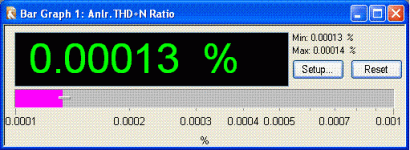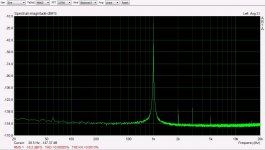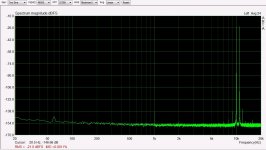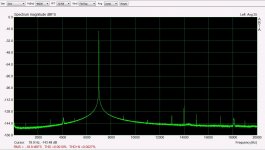Your KH4402 looks like it needs a tuneup. My KH4400 is consistently .0003%.
OK Martin, I played with the AGC trimmer, connected a jumper from the chassis to the ground on the AP and used the shortest BNC cable I have. The box for the 4402 isn't plastic, as I had mentioned previously.
Attachments
You can find the complete manual on-line. What I found surprising, is that it achieves that performance using a simple twin-T notch filter - and tunes the filter with Vactrol-style optocouplers (LED's shining on CdS light-dependent resistors)!
Dale
You will find that the Twin T is used in all distortion analyzers. The super premium solution seems to be a twin t passive in front of the active circuitry, at least that seems to be what Rohde and Schwartz do. The vactrol tuning is pretty common. Newer boxes may use FET's and VCA's for tuning.
If you have a link for the manual I would appreciate it. Saves me scanning the fragment I have.
A big nuisance I have to deal with is the residual hum current between the two ground posts on the front of my Boonton 1120. Its enough to degrade these super low measurements. But not enough to make a difference on real audio circuits.
i'd like to take a look at that article. don't remember seeing it before.
thanks,
mlloyd1
thanks,
mlloyd1
I have a JLH Distortion meter article if anybody is interested.
Your KH4402 looks like it needs a tuneup. My KH4400 is consistently .0003%. Its box stock. Every time I feel like hot-rodding it I realize I have 2 ShibaSoku oscillators (earlier versions of this http://www.shibasoku.com/download/avc/ag15c_e.pdf ) that are 20 dB better (less than .00001%) and what's the point? Any of these are better than anything we build that is useful.
Any idea why this KH4400 is doing .00005%? I'll ask if he did any mods:
http://www.diyaudio.com/forums/equi...ject-audio-measurements-tool.html#post2072409
I have no idea how it measured so well. I have that EVM from TI. I could not get it working so i passed it back to TI. It took them a while to figure it out and I have not tested it yet. Something for tomorrow. I'll duplicate the measurements only with Praxis and see what I learn.
It so happens that I just got this evm as well, a few days ago. I got it to work and will post some results soon. But no, my results are not not as good as ghg's from this other thread
http://www.diyaudio.com/forums/equi...t-audio-measurements-tool-17.html#post2664252
http://www.diyaudio.com/forums/equi...t-audio-measurements-tool-17.html#post2664252
Here you go. These settings correspond to 48kHz, master clock configuration. My EMU 0404 USB is set as slave.
SW1
===
unused: hi
dsdmode: lo
moden: lo
dsden: lo
df: lo
fs1: lo
fs0: lo
hpfdl: hi
hpfdr: hi
pcmen: hi
SW2
===
sub0: lo
sub1: lo
SW3
===
fmt0: lo
fmt1: lo
owl0: lo
owl1: lo
s/m: lo
/dit: lo
ditclk1: hi
ditclk0: hi
ditfmt: lo
ditmono: lo
SW6
===
unused: hi
x2: hi
x1: lo
extclk: hi
SW1
===
unused: hi
dsdmode: lo
moden: lo
dsden: lo
df: lo
fs1: lo
fs0: lo
hpfdl: hi
hpfdr: hi
pcmen: hi
SW2
===
sub0: lo
sub1: lo
SW3
===
fmt0: lo
fmt1: lo
owl0: lo
owl1: lo
s/m: lo
/dit: lo
ditclk1: hi
ditclk0: hi
ditfmt: lo
ditmono: lo
SW6
===
unused: hi
x2: hi
x1: lo
extclk: hi
Thanks. I checked and the board is now working (at least something is coming out the AES connectors). They were dead when I got it an not combination of switches that seemed relevant would get any data happening. I made my FAE go figure it out. there is a switch that will shut it down in effect that isn't well documented. There is much room for confusion but your set up will help be get it going. I presume lo=on?
The measurements are not as impressive as user ghg has posted, thd of 0.00005?!? I still wonder how his Krohn-Hite 4400A could have such small distortion. But anyway, my measurement with a sample frequency of 48kHz. The chain was:
laptop -> EMU0404 USB -> 0404 balanced analog output 1/4in -> pcm4222evm balanced analog input 1/4in -> pcm4222evm s/pdif/aes3 digital output -> 0404 coax digital input (set on aes3) -> laptop running ARTA spectrum analyzer v1.7
The pcm4222evm was set as master via the S/M dip switch, and laptop was set to be slave in the 0404 software.
The pcm4222evm was powered via an analog regulated supply +- 15V, and +5V. A note of caution: before earthing this power supply GND output the pcm4222evm had huge noise. all over the place.
laptop -> EMU0404 USB -> 0404 balanced analog output 1/4in -> pcm4222evm balanced analog input 1/4in -> pcm4222evm s/pdif/aes3 digital output -> 0404 coax digital input (set on aes3) -> laptop running ARTA spectrum analyzer v1.7
The pcm4222evm was set as master via the S/M dip switch, and laptop was set to be slave in the 0404 software.
The pcm4222evm was powered via an analog regulated supply +- 15V, and +5V. A note of caution: before earthing this power supply GND output the pcm4222evm had huge noise. all over the place.
Attachments
The measurements are not as impressive as user ghg has posted, thd of 0.00005?!? I still wonder how his Krohn-Hite 4400A could have such small distortion.
I wonder if you change out the AGC adjust trimmer to a 25-turn unit you might be able to trim the whiskers a bit more finely. It takes some patience, and you should pick a time of day when there's not a bunch of EMI being generated by triacs, blowers, hair conditioners etc.
The TI eval boards are pretty nice tools.
He just answered something to that effect:
http://www.diyaudio.com/forums/equi...erter-project-audio-measurements-tool-17.html
http://www.diyaudio.com/forums/equi...erter-project-audio-measurements-tool-17.html
My scope has an FFT function, but I don't know what kind of signal one needs to feed it to do the test, any help?
Feed it a 1kHz sine wave generate by a sound card.
Ikoflexor: thanks!
Do you think adding a DIT to the EMU in a similar fashion that the PCM4222 EVM does and using a balanced digital cable between the units would be worthwhile?
Sorry, I don't understand the first question. I don't have a balanced digital input on the EMU, so couldn't test if it would be better than the coax unbalanced input. But I did noticed something wrt cables. I had two sets of RCA cables. For some reason there was a lot of high frequency noise when I used one of the cables for the digital connection between the pcm4222evm and EMU. Couldn't understand why, but when I used the other cable all that noise disappeared.
Hi!
Just a quickie one - can someone re-upload the three parts of the Cordell Analyzer article again for me please? - I'm still trying to build mine and the pdfs I saved are long gone!
Bob has made it available on his site but it's nothing like as clear as the three separate pdfs!
Chris Williams
Just a quickie one - can someone re-upload the three parts of the Cordell Analyzer article again for me please? - I'm still trying to build mine and the pdfs I saved are long gone!
Bob has made it available on his site but it's nothing like as clear as the three separate pdfs!
Chris Williams
- Home
- Design & Build
- Equipment & Tools
- DIY Distortion Analyzer/Analysis?



